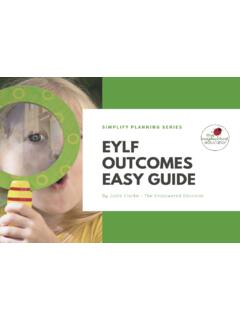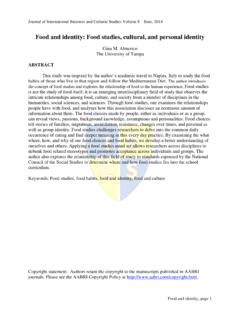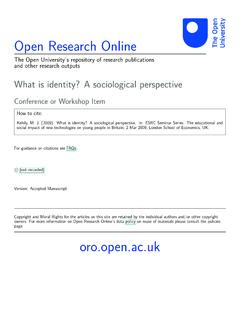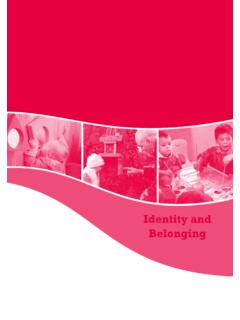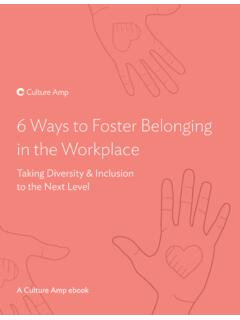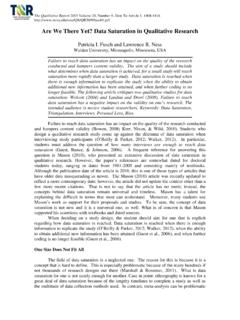Transcription of A Literature Review of the Factors Influencing E ... - ed
1 A Literature Review of the Factors Influencing E-Learning and Blended Learning in Relation to Learning Outcome, Student Satisfaction and Engagement Anne-Mette Nortvig, Anne Kristine Petersen and S ren Hattesen Balle University College Absalon, Denmark Abstract: In higher education, e-learning is gaining more and more impact, especially in the format of blended learning, and this new kind of traditional teaching and learning can be practiced in many ways. Several studies have compared face- to-face teaching to online learning and/or blended learning in order to try to define which of the formats provides, , the highest learning outcome, creates the most satisfied students or has the highest rate of course completion. However, these studies often show that teaching and learning are influenced by more than teaching format alone. Many Factors play significant roles, and this Literature Review will look further into some of them. The Review has a special interest in professional bachelor education and teacher training, and it focusses on Factors that influence learning experiences in e-learning, online learning and blended learning.
2 Thus, the research question of the Review is as follows: Which Factors are found to influence e-learning and blended learning in relation to learning outcome, student satisfaction and engagement in collaboration in higher education and particularly in professional education? The findings from the research papers included in the Review show that among the many Factors some seem to dominate more: educator presence in online settings, interactions between students, teachers and content, and designed connections between online and offline activities as well as between campus-related and practice-related activities. The article thus points in the direction of some significant Factors , but it also discusses and questions the relevance of research focusing on comparisons between individual formats of e-learning, online learning, blended learning or "traditional" face- to-face teaching and learning. Teaching and learning are complex and are influenced by more than just the teaching format.
3 The Review is based on systematic database searches conducted in January 2017, and it includes 44 peer reviewed articles and papers published between 2014 and 2017. Keywords: e-learning, online learning, blended learning, hybrid learning, learning outcome, student satisfaction, collaboration 1. Introduction In the Literature reviewed, a great number of studies have aimed at determining whether computer-mediated education in the form of e-learning, blended learning or hybrid learning is better than traditional face-to-face teaching in relation to, for instance, learning outcome and student satisfaction. Researchers, educators and educational decision makers alike are eager to find out which format leads to the best results for their students and the educational institutions. However, as we shall see below, comparative studies of educational formats show different results, which might indicate that Factors other than the format alone influence learning outcome, satisfaction, student retention et cetera.
4 In this Review of the Literature on e-learning, we present and discuss definitions of e-learning, hybrid learning and blended learning, and we Review the Literature comparing different online teaching formats with traditional on-campus/face-to-face teaching. With this point of departure, we explore which Factors affect students' learning experiences in different online formats in higher education, with particular emphasis on professional education and teacher training. The Review serves to show that some Factors are more prominent than others, and these Factors , including spaces, learning community and student identity , course design and the educator's role, are further discussed. Methods The Literature search on which the present Review is based (Bryman, 2012; Creswell, 2013; Machi & McEvoy, 2016), serves the purpose of identifying papers that may contribute to answering the following research ISSN 1479-4403 46 ACPIL. Reference this paper: Nortvig, A.
5 M., Petersen, A. K., and Balle, S. H., 2018. A Literature Review of the Factors Influencing E- Learning and Blended Learning in Relation to Learning Outcome, Student Satisfaction and Engagement. The Electronic Journal of e-Learning, 16(1), pp. 46-55, available online at Anne-Mette Nortvig, Anne Kristine Petersen and S ren Hattesen Balle question: which Factors are found to influence e-learning and blended learning in relation to learning outcome, student satisfaction and engagement in collaboration in higher education and particularly in professional education? A systematic search in the Educational Resource Information Center (ERIC) and ProQuest databases was carried out in January 2017, using the search keywords [ e-learning OR online learning OR blended learning OR hybrid learning ] AND [ innovation OR teacher education OR learning outcome OR. collaboration OR satisfaction ]. To ensure that the latest findings are presented in the Review , the systematic search was restricted to articles published between 2014-2017.
6 The database searches generated a total of 135 articles. The authors read the full articles, discussed how to categorize them and, eventually, 93 articles were selected as relevant and grouped into 13 major categories that affect e-learning and blended learning in higher education. The 13 categories were further reduced to five categories based on an estimate of which categories were most dominant, the categories that involved the highest number of hits. Thus, the Review draws on a total of 44 articles and addresses the following categories: spaces, learning community and student identity , course design and educator roles. More papers are published in 2015 (20 papers) than in 2016 (13 papers) and 2014 (11 papers), but all categories are discussed throughout the period. Below, we present the results from our reading and analysis of the articles included in the Review by starting out with a discussion of the selected comparison studies on online, blended and face-to-face (F2F) formats.
7 Comparison studies on online, blended and F2F formats Several studies ( , Bernard et al., 2014; Chigeza and Halbert, 2014; Gonz lez-G mez et al., 2016; Israel, 2015; Northey et al., 2015; Ryan et al., 2016; Southard, Meddaug and Harris, 2015) have compared F2F. teaching to online learning and/or blended learning in order to try to define which of the formats provides, , the highest learning outcome, creates the most satisfied students or has the highest rate of course completion. In the following, we make an introductory Review of recent comparative studies of the three formats mentioned. The main focus will be on summing up the results developed by these studies and discussing some of the limitations said to accrue to comparative studies of teaching formats. In the Literature reviewed, it is often shown that teaching and learning are influenced by more than teaching format alone as many other Factors play significant roles. Before embarking on our comparative Review of the three different teaching and learning formats, we will begin by clarifying how each of them is definable according to studies of the different formats.
8 Although there has not been complete agreement among researchers about the precise definition or meaning of the term blended learning' in particular (Bernard et al., 2014; Chigeza and Halbert, 2014), consensus has still built up around a sense of fairly clear distinctions between the three formats. Definitional questions do not, however, seem to haunt the terms face-to-face learning' and online learning' in the same way as they do blended learning' in the articles reviewed. Their meaning appears to be more or less agreed upon. For instance, the F2F learning format is characterized as traditional by many of the authors, referring to the fact that this is the format with the longest history of the three formats and in relation to which online and blended learning represent a modern or innovative intervention ( , Chigeza and Halbert, 2014; Adams, Randall and Traustad ttir, 2015; Pellas and Kazandis, 2015; Gonz lez-G mez et al., 2016).
9 Generally, its meaning derives from an understanding of an instructional format that involves a physical classroom and the synchronous physical presence of all participants ( , teachers and students). One study emphasizes that even in-class use of computers and educational technology does not affect the definition of the F2F format so as to change it into blended learning (Bernard et al., 2014). Online learning is commonly defined in contradistinction to F2F learning ( , Ryan et al., 2016). Its most prominent feature is the absence of the physical classroom, which is replaced by the use of web-based technologies offering opportunities for out-of-class learning independent of time, place and pace (Bernard et al., 2014; Chigeza and Halbert, 2014; Northey et al., 2015; Israel, 2015; Potter, 2015). Ryan et al. (2016) point out that in the context of higher education, the phrase online learning is often interpreted as referencing courses that are offered completely online; [.]
10 ] (p. 286). Typically, the online learning setting is launched through so-called learning management systems (LMS) or virtual learning environments (VLE) such as Moodle and Blackboard (Pellas and Kazanidis, 2015). 47 ISSN 1479-4403. The Electronic Journal of e-Learning Volume 16 Issue 1 2018. The terms blended learning and hybrid learning sometimes seem to be used interchangeably (Ryan et al., 2016). According to Bernard et al. (2014), who builds on Graham's definition (2005), blended learning can be defined as the combination of instruction from two historically separate models of teaching and learning: traditional F2F learning systems and distributed learning systems (p. 91). In some cases, blended learning is seen as the more effective counterpart to the other two formats used separately (Pellas and Kazandis, 2015;. Gonz lez-G mez et al., 2016) insofar as it is, , characterized as F2F and online learning being optimally integrated (Israel, 2015) or combining their benefits (Adams, Randall and Traustad ttir, 2015).











